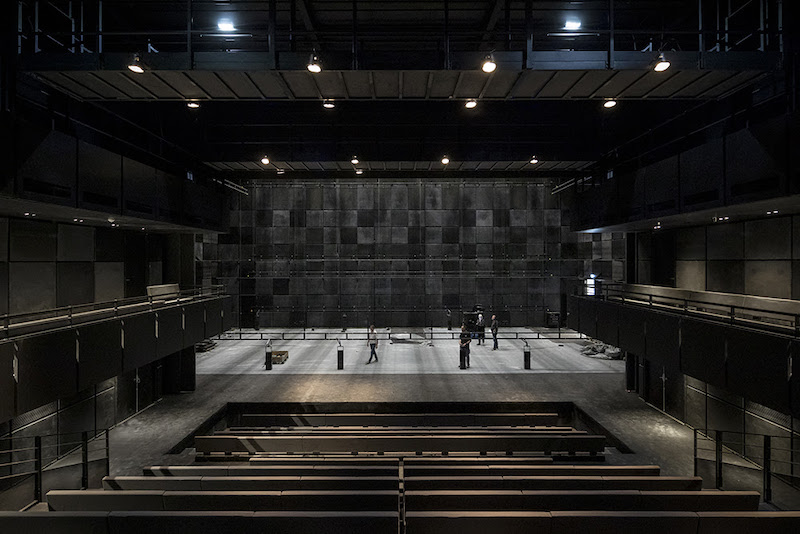The new 18,000-sm Maison de l’Économie Créative et de la Culture en Aquitaine, or MÉCA, brings together FRAC for contemporary art, ALCA for cinema, literature, and audiovisuals, and OARA for performing arts, into one cultural loop. BIG and FREAKS freearchitects were selected to design the art and culture building back in 2012.
A series of steps and ramps leads from the pavement of the promenade, passed the façade that provides glimpses into the stage towers of OARA and the offices of ALCA, and into the 1,100-sm outdoor urban room at MÉCA’s core. During special occasions, the outdoor urban room (and other outdoor spaces) can be turned into a stage for concerts and theatrical performances, or an extended gallery for sculptures and other art installations. The façade comprises 4,800 prefabricated concrete panels interspersed with windows of various sizes to control the amount of light entering inside. The 1.6-ton concrete slabs are sandblasted to expose their raw qualities and to texture the surface with the local sandstone of Bordeaux.

When visitors enter MÉCA from the ground floor, they will be met with a lobby where they can relax in the spiral pit or dine at Le CREM, a restaurant furnished with red furniture and cork chairs, a reference to the wine the city is known for. Near the restaurant, a giant periscope allows visitors to see the activity in the outdoor urban room and vice-versa.

Also on the ground floor is OARA’s 250-seat theater. It features flexible seating configurations and acoustic systems optimized by an all-black checkerboard panel of concrete, wood, and perforated metal. On the second floor is an 80-seat, red-accented cinema and two production offices and project incubation areas. FRAC occupies the upper floors. These spaces include seven-meter-high exhibition spaces, production studios for artists, storage facilities, and a 90-seat auditorium and café.
Topping off the entire building is an 850-sm public roof terrace. The terrace serves as an extension of the exhibitions spaces and provides space for large-scale art installations and outdoor performances.





Related Stories
| Aug 11, 2010
Best AEC Firms of 2011/12
Later this year, we will launch Best AEC Firms 2012. We’re looking for firms that create truly positive workplaces for their AEC professionals and support staff. Keep an eye on this page for entry information. +
| Aug 11, 2010
Clark Group, Mortenson among nation's busiest state/local government contractors, according to BD+C's Giants 300 report
A ranking of the Top 40 State/Local Government Contractors based on Building Design+Construction's 2009 Giants 300 survey. For more Giants 300 rankings, visit /giants
| Aug 11, 2010
Call for entries: Building enclosure design awards
The Boston Society of Architects and the Boston chapter of the Building Enclosure Council (BEC-Boston) have announced a High Performance Building award that will assess building enclosure innovation through the demonstrated design, construction, and operation of the building enclosure.
| Aug 11, 2010
Portland Cement Association offers blast resistant design guide for reinforced concrete structures
Developed for designers and engineers, "Blast Resistant Design Guide for Reinforced Concrete Structures" provides a practical treatment of the design of cast-in-place reinforced concrete structures to resist the effects of blast loads. It explains the principles of blast-resistant design, and how to determine the kind and degree of resistance a structure needs as well as how to specify the required materials and details.
| Aug 11, 2010
Jacobs, CH2M Hill, AECOM top BD+C's ranking of the 75 largest federal government design firms
A ranking of the Top 75 Federal Government Design Firms based on Building Design+Construction's 2009 Giants 300 survey. For more Giants 300 rankings, visit http://www.BDCnetwork.com/Giants
| Aug 11, 2010
Manhattan's Pier 57 to be transformed into cultural center, small business incubator, and public park as part of $210 million redevelopment plan
LOT-EK, Beyer Blinder Belle, and West 8 have been selected as the design team for Hudson River Park’s Pier 57 at 15th Street and the Hudson River as part of the development group led by New York-based real estate developer YoungWoo & Associates. The 375,000 square foot vacant, former passenger ship terminal will be transformed into a cultural center, small business incubator, and public park, including a rooftop venue for the Tribeca Film Festival.
| Aug 11, 2010
Gensler, HOK, HDR among the nation's leading reconstruction design firms, according to BD+C's Giants 300 report
A ranking of the Top 100 Reconstruction Design Firms based on Building Design+Construction's 2009 Giants 300 survey. For more Giants 300 rankings, visit http://www.BDCnetwork.com/Giants
| Aug 11, 2010
Bowdoin College Museum of Art
Brunswick, Maine
Since its founding in 1794, when what is now the state of Maine was still part of the Commonwealth of Massachusetts, Bowdoin College has played a pivotal role in the educational and cultural life of Maine. Contributing to that role for more than a century has been the Walker Art Building, an 1894 McKim, Mead & White-designed structure and home to the college’s Museum of Art.







